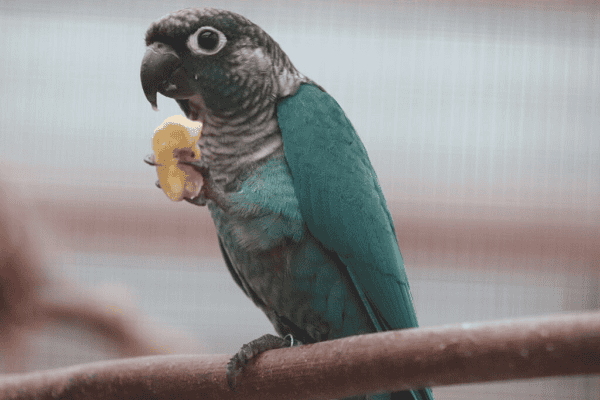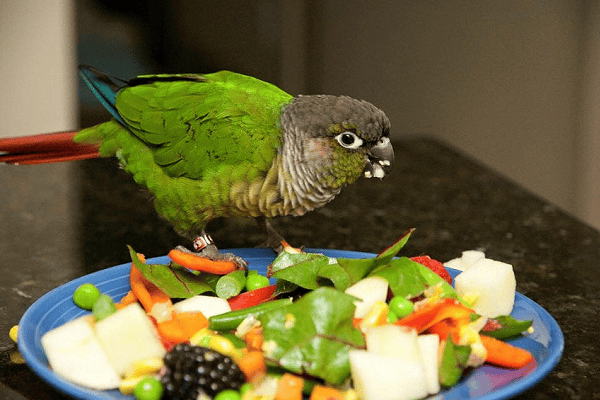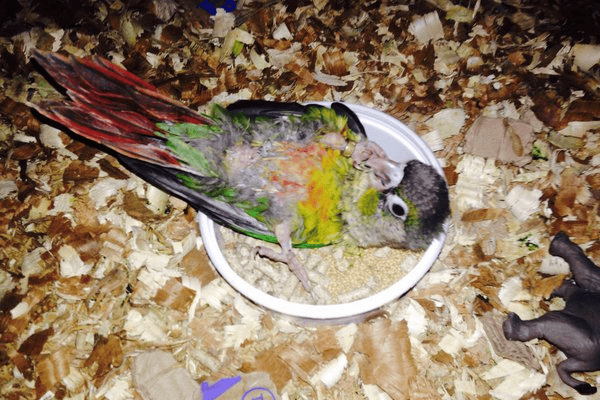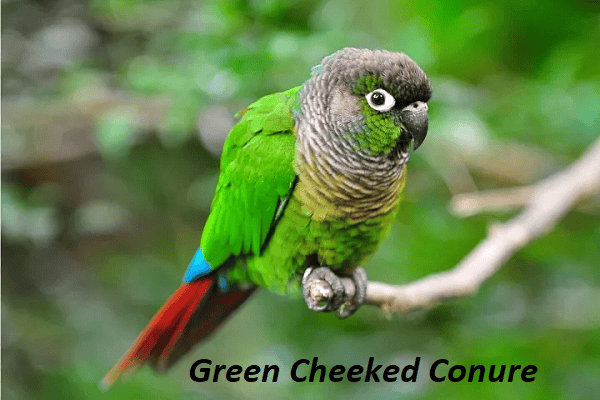Did you know that green cheeked parakeet, commonly known as the green-cheeked conure or by its scientific name, pyrrhura molinaes are one of the most popular pet birds in the United States?
The pineapple green cheek conure is a delightful bird that’s the result of carefully mixing opaline and cinnamon conures. Moreover, their stunning feathers shine with the vibrant hues of a perfectly ripe pineapple. These birds are perfect for first-time pet owners because they’re super easy to look after, they’re not too large, and they have a really friendly nature.
Furthermore, pineapple green cheek conures are well-suited to life as beloved pets, adding a splash of tropical color to homes all over the world. Plus, their sociable size makes them a top pick for both bird beginners and pros. They’re especially good for apartment dwellers or those who might be worried about the noise of a parrot, since pineapple conures tend to be quieter. Besides this, as you get to know the joys of having a pineapple green cheek conure, prepare to be captivated by their loving antics and the happy vibes they spread wherever they go
Here are the main points to note:
- Green cheeked conures are one of the most popular pet birds in the United States.
- Proper care and attention are necessary for green cheeked conures to thrive.
- This comprehensive guide will cover all aspects of green cheeked conure care.
- Topics include diet, habitat, behavior, socialization, health, and enrichment.
- By following these tips, you can ensure a happy and healthy life for your green cheeked conure.
Getting to Know Your Green Cheeked Conure
Before bringing a green cheeked conure into your home, it’s important to understand their unique characteristics and behavior. These charming birds belong to the conure species, specifically the green-cheeked conure, or green cheek conure as they are commonly known. Let’s explore their fascinating behavior traits and characteristics.
The Green Cheeked Conure Species

The green cheeked conure is one of the most popular conure species kept as pets. These small and vibrant birds are native to South America and are known for their playful and energetic nature. With their striking plumage and endearing personalities, green cheeked conures make delightful companions for bird enthusiasts.
Distinctive Behavior Traits
Green cheeked conures are highly sociable and intelligent creatures. They thrive on interaction and require mental stimulation to lead fulfilling lives. Known for their mischievous nature, they often demonstrate playful behavior, such as hanging upside down, climbing, and engaging in acrobatics.
These conures, belonging to the pyrrhura molinae bird species, are also renowned for their vocalizations. They have a wide range of calls, including chirps, squawks, and even mimicry of human speech. However, their vocalizations are typically not as loud or persistent as some other parrot species.
“Green cheeked conures are known for their curious and explorative nature. They love investigating toys, chewing on various objects, and exploring their surroundings. Providing them with plenty of toys and mental stimulation is essential for their well-being.” – Green Cheeked Conure Expert
Diet and Nutrition
A balanced diet is vital for the health of your green cheeked conure. Their diet should consist of a variety of fruits, vegetables, pellets, and occasional treats. It’s important to avoid feeding them avocados, chocolate, caffeine, alcohol, and other toxic foods. Consult with an avian veterinarian for specific dietary recommendations for your green cheeked conure.
Training and Socialization
Green cheeked conures are highly trainable and enjoy learning new tricks. With positive reinforcement and patience, you can teach them to perch on your hand, perform simple commands, and even participate in interactive games.
Proper socialization is crucial for green cheeked conures to develop trust and bond with their owners. Introduce your conure to new experiences, environments, and people gradually, ensuring they feel safe and secure throughout the process.
Creating the Perfect Habitat for Your Green-Cheeked Conure
Providing a suitable habitat is key to ensuring the overall well-being of your green-cheeked conure. Here, we will take a closer look at the ideal cage setup, perches, toys, diet, and the lifespan of these delightful pets.
Cage Setup
When choosing a cage for your green cheeked conure, opt for one that is spacious and secure. The cage should be large enough for your green cheeked parakeet to move around comfortably and stretch its wings. Make sure the bars are close together to prevent your conure from escaping.

Line the bottom of the cage with newspaper or other suitable bedding material that is safe for birds. This will make cleaning easier and provide a comfortable surface for your conure to walk on.
Perches and Toys
Green cheeked conures enjoy climbing and playing, so it’s important to include a variety of perches and toys in their cage. Provide different types of perches, such as natural wood branches of various sizes, to promote foot health and exercise.
As for toys, offer a mix of chewable toys, puzzle toys, and interactive toys to keep your conure mentally stimulated. Rotate the toys regularly to prevent boredom and ensure ongoing engagement.
Diet
A well-balanced diet is crucial for the health and longevity of your green cheeked conure. Their diet should consist of a combination of high-quality pellets, fresh fruits, and vegetables.
Introduce a variety of fruits (such as apples, bananas, and berries) and vegetables (such as leafy greens, carrots, and bell peppers) into their diet to ensure they receive all the essential nutrients.
Remember to provide fresh, clean water at all times for your conure.
Lifespan
The average lifespan of a green cheeked conure is approximately 10-15 years, although they can live longer with proper care and a healthy lifestyle.
| Lifespan Expectancy | Factors Affecting Lifespan |
|---|---|
| 10-15 years | Proper nutrition Regular veterinary check-ups Safe and stimulating environment Affectionate and social interactions Reduced stress levels |
By providing the right habitat, including a suitable cage setup, perches, toys, and a balanced diet, you can help ensure a long and happy life for your green cheeked conure.
Socializing and Training Your Green Cheeked Conure
Green-cheeked conures are highly social and intelligent birds that thrive on human interaction. To ensure their well-being and happiness, it is crucial to properly socialize and train them. By doing so, you can establish a strong bond and foster their mental stimulation.
Green-cheeked parakeet socialization plays a vital role in their overall development, emphasizing the importance of understanding the temperament of bird species like the green-cheeked conure. It involves exposing your conure to a variety of people, environments, and experiences from an early age. This helps them become comfortable and confident in different situations. Here are some tips to effectively socialize your cheeked conure:
- Start early: Begin socializing your conure as soon as you bring them home. This allows them to adapt to their new surroundings and build trust with you.
- Positive reinforcement: Reward your conure with treats, praises, and gentle strokes when they exhibit calm and friendly behavior. This encourages them to associate positive experiences with social interactions.
- Gradual exposure: Introduce your conure to different people, including family members, friends, and neighbors. Start with shorter interactions and gradually increase the duration as they become more comfortable.
- Variety of environments: Take your conure to different areas of your home and expose them to different sounds and sights. This helps them become accustomed to new environments and reduces anxiety.
- Introduce new experiences: Take your conure on short outings, such as car rides or visits to pet-friendly stores. Expose them to new stimuli, such as new sounds, smells, and visuals. Always prioritize their safety and well-being during these experiences, especially when considering the delicate nature of bird species such as the green cheeked parakeet.
In addition to socialization, training is essential for green cheeked conures to develop good behavior and learn basic commands. Here are some training tips to help you establish a positive and obedient relationship with your conure:
“Training is a great way to engage with your green cheeked conure and stimulate their intelligent mind. With patience and positive reinforcement, you can achieve impressive results.” – Avian expert, Dr. Jane Smith
Step-by-Step Training Guide:
- Start with basics: Begin by teaching your conure simple commands like “step up” and “step down.” Use positive reinforcement, such as treats or praise, to reward them when they respond correctly.
- Consistency is key: Be consistent with your training sessions and use the same command words and gestures each time. This helps your green-cheeked parakeet understand what is expected of them.
- Be patient: Understand that training takes time and repetition. Your conure may not grasp a command immediately, so be patient and continue practicing until they understand.
- Clicker training: Consider incorporating clicker training, where a clicking sound is used to mark desired behavior, followed by a reward. This can help your conure associate the clicker sound with positive outcomes.
- Encourage interactive toys: Use interactive toys, such as puzzle toys or foraging toys, during training sessions to stimulate your conure mentally and keep them engaged.
- Seek professional guidance: If you encounter difficulties or have specific training goals in mind, consult a professional avian trainer or behaviorist to guide you and provide expert advice.
Remember, training should always be conducted in a positive and patient manner. Never use punishment or force as it can damage the trust and bond with your conure.
| Benefits of Socializing and Training Your Green Cheeked Conure |
|---|
| 1. Strengthened bond: Socializing and training your conure helps build a strong bond based on trust and communication. This enhances your relationship and creates a fulfilling companionship. |
| 2. Mental stimulation: Green cheeked conures are intelligent birds that require mental stimulation to prevent boredom and behavioral issues. Socializing and training provide mental challenges that keep their minds active and engaged. |
| 3. Well-behaved behavior: Through consistent training, your conure learns appropriate behaviors and commands, making them a well-behaved and enjoyable companion in your home and in social situations. |
By dedicating time and effort to cheeked conure socialization and training, you can build a strong, loving bond with your feathered friend and ensure their overall well-being. Remember to provide positive reinforcement, be patient, and seek professional guidance when needed. With the right approach, you will have a happy and well-adjusted green cheeked conure.
Maintaining the Health and Well-being of Your Green Cheeked Conure
Proper healthcare is vital for keeping your green cheeked conure healthy and happy. Regular check-ups and proper maintenance ensure their overall well-being. Here are some key considerations:
Dedicated Avian Veterinarian

When it comes to the health of your green cheeked parakeet, it’s important to find a trusted breeder. avian veterinarian. Seek out a veterinarian who specializes in avian care and has experience with conures. Regular check-ups with an avian veterinarian are essential to catch any health issues early on and provide the necessary preventive care.
Conure Care Basics
Taking proper care of your green cheeked conure involves a few essential aspects:
- Provide a well-balanced diet that includes fresh fruits, vegetables, pellets, and occasional treats. Consult with your avian veterinarian regarding the specific dietary needs of your conure.
- Ensure your green cheeked conure has a clean and spacious habitat with appropriate perches, toys, and a variety of stimulating activities.
- Regularly clean the cage and provide fresh water daily.
By following these conure care basics, you can help prevent common health issues and support your green cheeked conure’s overall well-being.
Common Health Issues
While green cheeked conures are generally hardy birds, they can still experience certain health issues. Here are a few common health problems to be aware of:
| Common Health Issues | Symptoms |
|---|---|
| Respiratory infections | Sneezing, wheezing, difficulty breathing |
| Feather plucking | Bald patches, excessive preening |
| Psittacine beak and feather disease | Feather abnormalities, beak deformities |
If you notice any unusual behavior or symptoms in your green cheeked conure, it’s important to consult your avian veterinarian for proper diagnosis and treatment.
Remember, prevention is key when it comes to the health of your green cheeked conure. Regular veterinary check-ups, a balanced diet, and a clean environment can help your feathered friend stay healthy and happy for years to come.
Fun Activities and Enrichment for Your Green Cheeked Conure
Green cheeked conures have a playful and curious nature. They thrive in environments that provide them with mental stimulation and opportunities for playtime. Engaging in fun activities and providing enrichment for your green cheeked conure is not only enjoyable for them, but it also helps to keep them happy and healthy.
One of the best ways to provide mental stimulation for your green cheeked conure is through interactive toys. Look for toys that encourage problem-solving and encourage physical activity, catering to the natural instincts of bird species like the green cheeked parakeet. Puzzle toys, for example, are a great way to keep your conure mentally engaged as they work to solve the puzzle and retrieve a treat.
Another fun activity for your green cheeked conure is to introduce them to foraging toys. These toys mimic the natural behavior of foraging for food, allowing your conure to use their natural instincts to find hidden treats or pellets. This not only keeps them mentally stimulated but also helps to prevent boredom, vital for maintaining the good temperament of bird species like the green cheeked parakeet.
In addition to toys, spending playtime with your green cheeked conure is important for their overall well-being. They enjoy interacting with their owners and being part of the family. You can create a designated play area for them where they can explore, climb, and play with various toys.
Consider providing different types of perches and ladders in their play area so they can exercise their feet and enjoy a change of scenery. Adding branches or ropes for them to swing on will also add an extra element of fun to their playtime.
Another great way to enrich your green cheeked conure’s playtime is through training. These birds are highly intelligent and can learn a variety of tricks. Teach them simple commands like ‘step-up,’ ‘wave,’ or even ‘fetch.’ Training sessions not only provide mental stimulation but also strengthen the bond between you and your conure.
Remember to supervise your green cheeked conure during playtime to ensure their safety. Avoid small parts or toys that could pose a choking hazard. Regularly inspect and clean their toys to maintain a clean and healthy environment.
Overall, providing fun activities and enrichment for your green cheeked conure is essential for their well-being. Their playful nature and need for mental stimulation make it important to engage them in interactive play and provide them with a stimulating environment. By doing so, you will have a happy and fulfilled green cheeked conure as a beloved companion.
Overcoming Challenges in Green-Cheeked Conure Ownership
Like any pet, green-cheeked conures may present certain challenges. Understanding their behavior and finding solutions to common issues is key to providing them with a happy and harmonious home. In this section, we will discuss some of the challenges you may encounter as a green cheeked conure owner and provide strategies for overcoming them.
Dealing with Nippiness
One common challenge owners face is nippiness in green cheeked conures. These playful birds may occasionally nip or bite, especially when they are feeling territorial or anxious. To address this behavior:
- Remain calm: Reacting strongly or pulling away when your conure nips may encourage the behavior.
- Redirect their attention: Offer a favorite toy or treat to distract them from nipping.
- Understand their body language: Learn to recognize signs of aggression or discomfort, such as fluffed feathers or dilated pupils, and give them space when needed.
- Positive reinforcement: Reward good behavior with praise or treats to encourage gentle interactions.
Consistency and patience are key when addressing nippiness. Remember that each bird is unique and may require individualized training and attention.
Managing Aggressive Behavior
Sometimes, green-cheeked conures, also known as green-cheeked parakeets, may display aggression towards humans or other pets. Aggressive behaviors can include biting, lunging, or territorial displays.
To manage and discourage aggressive behavior, understanding the temperament of your green cheeked parakeet is crucial.
- Discover the trigger: Observe your conure’s behavior to identify what may be causing their aggression. It could be environmental factors, such as changes in routine or new additions to the household.
- Remove or modify triggers: If possible, eliminate or minimize the triggers that lead to aggression. For example, if a specific person or pet causes your conure to act out, create separate spaces or introduce gradual introductions.
- Positive reinforcement training: Use positive reinforcement techniques to reward calm and gentle behavior. Avoid punishment-based training methods, as they can exacerbate aggression.
- Seek professional help: If aggression persists despite your efforts, consult a qualified avian veterinarian or an animal behaviorist for further guidance and professional advice.
Remember that managing aggression requires a combination of patience, consistency, and understanding of your conure’s needs and triggers.
Providing Mental Stimulation
Green cheeked conures are intelligent and active birds. Without adequate mental stimulation, they may develop behavioral problems or become bored. To prevent these issues:
- Offer enriching toys: Provide a variety of toys that encourage exploration, problem-solving, and physical activity.
- Rotate toys regularly: Change toys frequently to keep your conure engaged and prevent boredom.
- Training and tricks: Teach your green cheeked conure new tricks or engage in clicker training to stimulate their mind.
- Frequent out-of-cage time: Allow your conure time outside of their cage in a safe and supervised environment, allowing them to explore and interact with their surroundings.
A mentally stimulated conure is less likely to develop behavioral issues and will lead a happier and more fulfilled life.
Check Our Previous Articles:
| Common Challenges | Strategies for Overcoming Them |
|---|---|
| Nippiness | Remain calm, redirect attention, understand body language, and reinforce positive behavior. |
| Aggressive behavior | Identify triggers, remove or modify triggers, use positive reinforcement, and consider seeking professional help. |
| Mental stimulation | Provide enriching toys, rotate toys, engage in training, and allow frequent out-of-cage time. |
Wrapping Up…
Taking care of a green-cheeked parakeet, also known as a green-cheeked conure, is fun and rewarding. To keep your bird buddy happy and healthy, it’s important to feed them a mix of fresh fruits, veggies, and special bird pellets. Just like us, they need a balanced diet to stay in tip-top shape!
It’s also super important to hang out with your parakeet often and teach them cool tricks, which helps you both become best friends. Make sure their home is full of fun toys and things to do so they don’t get bored. If you follow the advice in this guide, you’ll make a cozy home for your feathery pal, and you’ll have lots of great times together.





Add comment